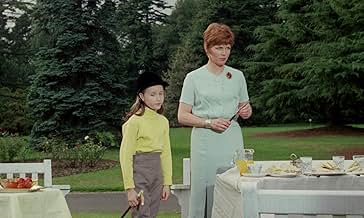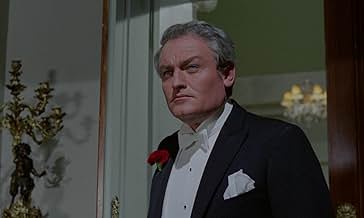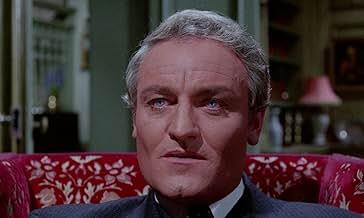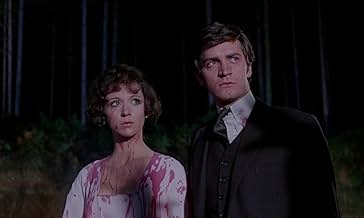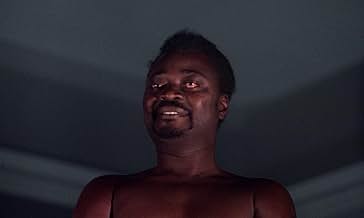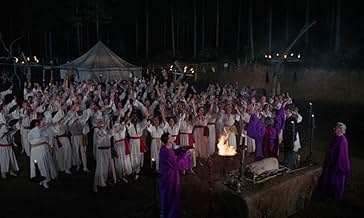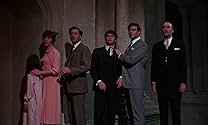CALIFICACIÓN DE IMDb
6.9/10
11 k
TU CALIFICACIÓN
Los adoradores del diablo planean convertir a dos nuevas víctimas.Los adoradores del diablo planean convertir a dos nuevas víctimas.Los adoradores del diablo planean convertir a dos nuevas víctimas.
- Dirección
- Guionistas
- Elenco
Nike Arrighi
- Tanith Carlisle
- (as Niké Arrighi)
Yemi Goodman Ajibade
- African
- (sin créditos)
Patrick Allen
- Rex Van Ryn
- (voz)
- (sin créditos)
Liane Aukin
- Satanist
- (sin créditos)
John Bown
- Receptionist
- (sin créditos)
Peter Brace
- Satanist
- (sin créditos)
John Falconer
- Satanist
- (sin créditos)
Anne Godley
- Satanist
- (sin créditos)
- Dirección
- Guionistas
- Todo el elenco y el equipo
- Producción, taquilla y más en IMDbPro
Opiniones destacadas
'The Devil Rides Out' is easily one of the most entertaining of Terence Fisher's Hammer movies. While best known for his Dracula and Frankenstein movies, this fascinating blend of adventure thriller and Satanic shocker is not to be overlooked. While technically a horror movie with strong supernatural elements, the movie's use of old fashioned thrills and Lee's dashing heroic character Duc de Richleau, gentleman and occult expert, give this one quite a unique flavour unlike most of the other Hammer classics. Lee is brilliant throughout, as is his nemesis the evil magician Mocata played by Charles Gray (Blofeld in 'Diamonds Are Forever'). The rest of the cast are also very effective. Leon Greene as Richleau's loyal friend Rex, Nike Arrighi as Tanith the mysterious girl rex becomes besotted with, and Patrick Mower as Simon, Richleau and Rex's young friend who foolishly dabbles with Satanism and soon finds himself under the control of Mocasta. The film is consistently interesting, with lots of excitement and some unpredictable plot twists. The Satanism is treated more seriously and realistically than many 1960s horror movies (and wait til you see "The Goat Of Mendes"!) , and this is a credit to Richard Matheson who adapted Dennis Wheatley's original novel. I am becoming increasingly aware of just how many movies I admire that Matheson had a hand in writing - many of Roger Corman's Poe series, 'The Legend Of Hell House' and 'The Last Man On Earth' to name a few. Matheson is one of the most talented and imaginative horror writers to ever work in Hollywood, and rarely gets the credit he deserves. 'The Devil Rides Out' is yet another fantastic movie from the Hammer studio, and highly recommended.
Heading the great Hammer Horror Revival was Terence Fisher, the director whose adaptations of the Universal horror classics, The Curse Of Frankenstein (1957), The Horror of Dracula (1958) and The Mummy (1959) sealed the studio's fate as the leading producer of British gothic horror for almost 20 years. Throughout the 60s, while half of Hammer's output were rather silly adventure yarns (The Viking Queen, The Vengeance Of She) and lazy exercises in generic conventions (Curse Of The Mummy's Tomb, The Old Dark House), Fisher created more adult-oriented horror - psychological, almost Freudian horror (The Gorgon, Frankenstein Created Woman), drawing on the sexual conflicts of the repressive English social climate starting to fray at the seams. Fisher's final film, Frankenstein And The Monster From Hell (1973) is British horror at its bleakest - a deeply disturbing and amoral portrait of amorality in the figure of Fisher's greatest creation, Baron Frankenstein as essayed by Hammer icon Peter Cushing. Over twenty years after his death he is still regarded as Britain's greatest ever horror director.
Fisher began work on The Devil Rides Out, the first of three Dennis Wheatley adaptations, in the summer of 1967. From the opening credits, an indecipherable mass of occult symbols appearing out of a red mist punctuated with James Bernard's ominous orchestral score, screenwriter Richard Matheson (I Am Legend author and scriptwriter of Roger Corman's Edgar Allen Poe series) sharpens Crowley's prose to create a frighteningly real world of dark forces at work beneath the genteel surface of the English aristocracy. At a reunion of old friends at a country estate, occult expert the Duc de Richelieu (Christopher Lee) and his well-meaning but impulsive lantern-jawed sidekick Rex (Leon Greene) discover their young comrade Simon (Patrick Mower) has become involved in `astrological society', a thinly-veiled satanic cult lead by the charismatic Mocata (Charles Gray). Richelieu and Rex kidnap Simon to prevent his Devil's baptism, but he escapes. Mocata then uses Richelieu's friends Richard (Yes Minister's Paul Eddington) and his family, and Tanith (Nike Arrighi), a young French beauty also marked for baptism, as bait to lure Richelieu to his destruction.
For a studio defined by its reworkings of Dracula and Frankenstein, Mocata is one of Hammer's most frightening monsters. Veteran Shakespearean actor Gray, best remembered these days as the Bond villain in Diamonds Are Forever (1971) and the narrator in The Rocky Horror Picture Show (1975), conveys the palpable menace from his cold, unflinching steel-gray eyes and his carefully modulated voice, a master of hypnosis and mind control no doubt based on real-life characters from Wheatley's days in British Intelligence (some say Mocata is smoother version of the `Great Beast', occultist Alistair Crowley, whom Wheatley was acquainted with). Matheson's script changes the Mocata character from a swarthy European figure of Word War 2-era intrigue into an English `gentleman', more forcefully underpinning the tension between England's exterior pastoral elegance and class respectability, and its repressed bacchanalian urges. Wheatley, a British author best known for his black magic tales and costume adventure stories, was an avid collector of occult esoterica and was reportedly delighted with the film, as Matheson's script had expanded on his own research his Black Magic rituals with an eye for detail, drawing on Crowley's writings as well as Sumerian and Egyptian legends, occult and pagan texts.
Of course the film's focus is on the imposing figure of the six foot four Christopher Lee, by 1967 a genre superstar having played Dracula, the Frankenstein monster, the Mummy, Rasputin, even Sherlock Holmes. Lee had in fact pressed Hammer to purchase the rights for Wheatley's novel, and was delighted to play a character on the side of `good' after a decade typecast as Dracula.
Hammer films are characterized by relatively low budgets, compensated by taut direction and expert characterization, and a winning combination of tight studio sets and English country exteriors. The Devil Rides Out utilizes its stagebound scenario to chilling effect: Simon's cold gray observatory turns malevolent purely by adding scratching noises from a cupboard. The budget only lets the film down in its two major setpieces; both the final sacrificial ceremony at Mocata's mansion and the Grand Sabbat, supposedly a grand ritual orgy for Simon and Tanith's intended baptism, veer toward poorly-staged pantomime. When Mocata invokes Satan (`The Goat of Mendes - the Devil himself!') at the Sabbat, the sight of a rather wretched figure with pin-on horns and raccoon eyes tends to blunt the scene's horrific implications. Indeed the film's scariest scene is set in an empty room; Richelieu, Rex and the family take refuge inside a chalk circle and are confronted by a series of apparitions conjured by Mocata. Again the scene is only marred by the final ghastly figure: a horsebound Angel of Death, whose mask drops to reveal a cheap-looking grinning plastic skull.
The Devil Rides Out was an artistic triumph but not a commercial success. Perhaps it was the unfamiliar tone of the film, or the fact Christopher Lee had his fangs filed down; two further Duc de Richelieu adventures starring Lee, Strange Conflict and Gateway To Hell were abandoned. Hammer's next venture after The Devil Rides Out, The Lost Continent (an ambitious reworking of Wheatley's Jules Verne style adventure novel Uncharted Seas) went wildly overbudget and Wheatley was not impressed, citing a number of plot changes by director Michael Carreras. The third Wheatley adaptation, a grotesque updating of To The Devil A Daughter with Richard Widmark and an embarrassed Christopher Lee, was Hammer's horror swansong in 1976, and the company sank soon after. Maybe it was the curse of Dennis Wheatley after all - still, for us horror iconoclasts, we still have The Devil Rides Out, a film that remains after 35 years one the finest examples of the gone but never to be forgotten house of Hammer.
Fisher began work on The Devil Rides Out, the first of three Dennis Wheatley adaptations, in the summer of 1967. From the opening credits, an indecipherable mass of occult symbols appearing out of a red mist punctuated with James Bernard's ominous orchestral score, screenwriter Richard Matheson (I Am Legend author and scriptwriter of Roger Corman's Edgar Allen Poe series) sharpens Crowley's prose to create a frighteningly real world of dark forces at work beneath the genteel surface of the English aristocracy. At a reunion of old friends at a country estate, occult expert the Duc de Richelieu (Christopher Lee) and his well-meaning but impulsive lantern-jawed sidekick Rex (Leon Greene) discover their young comrade Simon (Patrick Mower) has become involved in `astrological society', a thinly-veiled satanic cult lead by the charismatic Mocata (Charles Gray). Richelieu and Rex kidnap Simon to prevent his Devil's baptism, but he escapes. Mocata then uses Richelieu's friends Richard (Yes Minister's Paul Eddington) and his family, and Tanith (Nike Arrighi), a young French beauty also marked for baptism, as bait to lure Richelieu to his destruction.
For a studio defined by its reworkings of Dracula and Frankenstein, Mocata is one of Hammer's most frightening monsters. Veteran Shakespearean actor Gray, best remembered these days as the Bond villain in Diamonds Are Forever (1971) and the narrator in The Rocky Horror Picture Show (1975), conveys the palpable menace from his cold, unflinching steel-gray eyes and his carefully modulated voice, a master of hypnosis and mind control no doubt based on real-life characters from Wheatley's days in British Intelligence (some say Mocata is smoother version of the `Great Beast', occultist Alistair Crowley, whom Wheatley was acquainted with). Matheson's script changes the Mocata character from a swarthy European figure of Word War 2-era intrigue into an English `gentleman', more forcefully underpinning the tension between England's exterior pastoral elegance and class respectability, and its repressed bacchanalian urges. Wheatley, a British author best known for his black magic tales and costume adventure stories, was an avid collector of occult esoterica and was reportedly delighted with the film, as Matheson's script had expanded on his own research his Black Magic rituals with an eye for detail, drawing on Crowley's writings as well as Sumerian and Egyptian legends, occult and pagan texts.
Of course the film's focus is on the imposing figure of the six foot four Christopher Lee, by 1967 a genre superstar having played Dracula, the Frankenstein monster, the Mummy, Rasputin, even Sherlock Holmes. Lee had in fact pressed Hammer to purchase the rights for Wheatley's novel, and was delighted to play a character on the side of `good' after a decade typecast as Dracula.
Hammer films are characterized by relatively low budgets, compensated by taut direction and expert characterization, and a winning combination of tight studio sets and English country exteriors. The Devil Rides Out utilizes its stagebound scenario to chilling effect: Simon's cold gray observatory turns malevolent purely by adding scratching noises from a cupboard. The budget only lets the film down in its two major setpieces; both the final sacrificial ceremony at Mocata's mansion and the Grand Sabbat, supposedly a grand ritual orgy for Simon and Tanith's intended baptism, veer toward poorly-staged pantomime. When Mocata invokes Satan (`The Goat of Mendes - the Devil himself!') at the Sabbat, the sight of a rather wretched figure with pin-on horns and raccoon eyes tends to blunt the scene's horrific implications. Indeed the film's scariest scene is set in an empty room; Richelieu, Rex and the family take refuge inside a chalk circle and are confronted by a series of apparitions conjured by Mocata. Again the scene is only marred by the final ghastly figure: a horsebound Angel of Death, whose mask drops to reveal a cheap-looking grinning plastic skull.
The Devil Rides Out was an artistic triumph but not a commercial success. Perhaps it was the unfamiliar tone of the film, or the fact Christopher Lee had his fangs filed down; two further Duc de Richelieu adventures starring Lee, Strange Conflict and Gateway To Hell were abandoned. Hammer's next venture after The Devil Rides Out, The Lost Continent (an ambitious reworking of Wheatley's Jules Verne style adventure novel Uncharted Seas) went wildly overbudget and Wheatley was not impressed, citing a number of plot changes by director Michael Carreras. The third Wheatley adaptation, a grotesque updating of To The Devil A Daughter with Richard Widmark and an embarrassed Christopher Lee, was Hammer's horror swansong in 1976, and the company sank soon after. Maybe it was the curse of Dennis Wheatley after all - still, for us horror iconoclasts, we still have The Devil Rides Out, a film that remains after 35 years one the finest examples of the gone but never to be forgotten house of Hammer.
How on earth did it take me so long to see 'The Devil Rides Out' and to even hear of it? This is the sort of film that should have been seen by me years ago, being somebody who likes many of the Hammer Horror films and who has always loved Christopher Lee. It also had on board other much admired people and Hammer Horror regulars, namely Terence Fisher as director and James Bernard as composer. It was my dad who recommended it to me when we happened to be channel surfing and 'The Devil Rides Out' happened to be on.
After seeing 'The Devil Rides Out', my mind is still blown about how it took me so long to see it or even know of it. It is an absolute gem and is to me one of Hammer Horror's best, it is hardly surprising that it was Lee's (in a departure role at the time, having specialised as villains) favourite of theirs. It is still a very clever and genuinely unsettling film that has held up incredibly and surprisingly well, considering that there were films at the time from the genre and with a similar tone that come over as fairly cheesy now. To me there is nothing cheesy about 'The Devil Rides Out'. Also read the book since and this is a rare case of the film being better than the source material, leaner and creepier.
Sure, the special effects are not always great and a little wobbly such as the spider. Have though on reflection seen far worse-looking spiders in film and television, the notoriously awful one from the 'IT' mini-series anyone?
Otherwise there is very little to fault. Other than (some of) the effects 'The Devil Rides Out' is a good looking film, especially the eerie lighting in namely the Angel of Death, an effect that actually still looks scary, and and Ghost of Mendes sequences and the photography which is both sumptuous and menacing-looking. Bernard's score has a real ominous vibe throughout without being too intrusive or too loud, as does the sound quality. Especially the Angel of Death scene, audibly that was quite hair-raising stuff. Fisher directs intelligently and with a good feel for unnerving atmosphere.
Richard Matheson's script is pacey and always thought-provoking, with no signs of awkwardness or fat. The story never felt dull, even when it was not as horror-centric and had more talk, and the atmosphere at its best is shiver-inducing. The genuinely creepy Ghost of Mendes and Angel of Death scenes stand out (the latter is unforgettable), as does the very clever and unnerving climax that kept me in suspense.
Even when not playing a villain, Lee is still a very powerful presence and cuts a quite elegant figure. The other standout is Charles Gray, who was never this frightening before or since. The rest of the cast are all fine, but not quite in the same league as Lee and Gray.
In conclusion, devillishly good. No make that great. 9/10
After seeing 'The Devil Rides Out', my mind is still blown about how it took me so long to see it or even know of it. It is an absolute gem and is to me one of Hammer Horror's best, it is hardly surprising that it was Lee's (in a departure role at the time, having specialised as villains) favourite of theirs. It is still a very clever and genuinely unsettling film that has held up incredibly and surprisingly well, considering that there were films at the time from the genre and with a similar tone that come over as fairly cheesy now. To me there is nothing cheesy about 'The Devil Rides Out'. Also read the book since and this is a rare case of the film being better than the source material, leaner and creepier.
Sure, the special effects are not always great and a little wobbly such as the spider. Have though on reflection seen far worse-looking spiders in film and television, the notoriously awful one from the 'IT' mini-series anyone?
Otherwise there is very little to fault. Other than (some of) the effects 'The Devil Rides Out' is a good looking film, especially the eerie lighting in namely the Angel of Death, an effect that actually still looks scary, and and Ghost of Mendes sequences and the photography which is both sumptuous and menacing-looking. Bernard's score has a real ominous vibe throughout without being too intrusive or too loud, as does the sound quality. Especially the Angel of Death scene, audibly that was quite hair-raising stuff. Fisher directs intelligently and with a good feel for unnerving atmosphere.
Richard Matheson's script is pacey and always thought-provoking, with no signs of awkwardness or fat. The story never felt dull, even when it was not as horror-centric and had more talk, and the atmosphere at its best is shiver-inducing. The genuinely creepy Ghost of Mendes and Angel of Death scenes stand out (the latter is unforgettable), as does the very clever and unnerving climax that kept me in suspense.
Even when not playing a villain, Lee is still a very powerful presence and cuts a quite elegant figure. The other standout is Charles Gray, who was never this frightening before or since. The rest of the cast are all fine, but not quite in the same league as Lee and Gray.
In conclusion, devillishly good. No make that great. 9/10
One of Terrence Fisher's greatest directorial efforts certainly is this stylish, witty, thrilling adaptation of a Dennis Wheatley novel. Richard Matheson did the screenwriting honors, ad like most of what he touches, it turns to gold. This film has a wonderful score throughout, some superior set pieces and some pretty novel special effects for its day. But behind all of this is the central, universal battle between the forces of good and evil, represented by the characters of Christopher Lee and Charles Gray. Both actors do an excellent job. This may indeed be Christopher Lee's finest performance, which is all the more surprising since he not only plays a good man but also is in a role that Peter Cushing would have devoured. Lee, from the very onset of the film, plays a man well-versed in knowledge of the occult and whose presence literally steals scene after scene. His counterpart, the malevolent Charles Gray, is just as good as Lee's antithesis. Gray is an underrated actor whose presence also illuminates and transcends the screen. The film boasts some great scenes including the much heralded Angel of Death scene, and there is a great scene between Gray and Lee's niece. A tremendous film in many respects and one of Lee's best, Fisher's best and Hammer's best!
Very cool Hammer film from the great Terence Fisher with Christopher Lee playing the good guy for a change. Lee plays the Duc de Richleau who, along with his friend Rex Van Ryn (Leon Greene), rescues a late friend's son and a young woman from a Satanic cult led by a powerful man named Mocata (Charles Gray). Now holed up at a country estate, de Richleau and Rex must fight off Mocata and the forces of evil.
One of my favorite Hammer films. The screenplay comes from Richard Matheson, adapted from a novel by Dennis Wheatley. Fisher's direction is terrific. The movie has a great 1920s period look and at times a very creepy atmosphere. The cast is excellent, with Lee giving one of his best performances. Charles Gray gives a subdued turn that makes him all the more menacing. I really like this one and rewatch it more than most Hammer movies I own. It's an exciting, enjoyable movie that will surely please Lee and Hammer fans.
One of my favorite Hammer films. The screenplay comes from Richard Matheson, adapted from a novel by Dennis Wheatley. Fisher's direction is terrific. The movie has a great 1920s period look and at times a very creepy atmosphere. The cast is excellent, with Lee giving one of his best performances. Charles Gray gives a subdued turn that makes him all the more menacing. I really like this one and rewatch it more than most Hammer movies I own. It's an exciting, enjoyable movie that will surely please Lee and Hammer fans.
¿Sabías que…?
- TriviaThe film was made at Christopher Lee's insistence that Hammer do a movie based on a Wheatley fantasy novel.
- ErroresDuring the opening credits, a symbol is shown that is not Satanic, and it is also incorporated into the symbol on the priestly robes during the film. Inscribed within a Star of David, there is a six-winged seraph with the faces of a man, lion, ox and eagle based on the vision of Ezechiel. In Christian tradition, the four faces become associated with the four gospel writers: Matthew, Mark, Luke and John.
- Citas
Marie Eaton: [to her servant about Mocata] Show him out!
Mocata: I'm leaving.
[walks towards door and stands behind Marie]
Mocata: *I* shall not be back... but something will.
[pauses menacingly]
Mocata: Tonight! Something will come for Simon and the girl!
[leaves]
- Versiones alternativasThe 2012 UK Blu-ray Disc released by Studio Canal features digitally enhanced special effects. The makers of the Blu-ray claim to complete shots which had never been finished due to budget reasons:
- Matte shot of Simon's mansion with the Observatory dome has been replaced with a CGI background.
- During the ritual at the climax of the movie a lighting has been replaced with a new CGI lightning.
- Spider sequence: Shadow for the spider has been added, some matte shots enhanced, and digital smoke added when the spider is sprayed with holy water.
- The Angel of Death sequence: A light effect is illuminating the door to cover the poor original optical effect when the angel rides through the door. The close up of the Angel of Death has a new background with flames as the original intended shot was never finished.
- The matte shots of Charley Grey's death in the fire have been digitally corrected as there were optical errors in the layers of the matte shots.
- Several other matte shots have been improved by removing matte lines.
- ConexionesFeatured in Iron Maiden: The Number of the Beast (1982)
Selecciones populares
Inicia sesión para calificar y agrega a la lista de videos para obtener recomendaciones personalizadas
Detalles
- Fecha de lanzamiento
- País de origen
- Idioma
- También se conoce como
- The Devil Rides Out
- Locaciones de filmación
- Productoras
- Ver más créditos de la compañía en IMDbPro
- Tiempo de ejecución1 hora 36 minutos
- Relación de aspecto
- 1.66 : 1
Contribuir a esta página
Sugiere una edición o agrega el contenido que falta

Principales brechas de datos
What is the Italian language plot outline for La esposa maldita (1968)?
Responda

